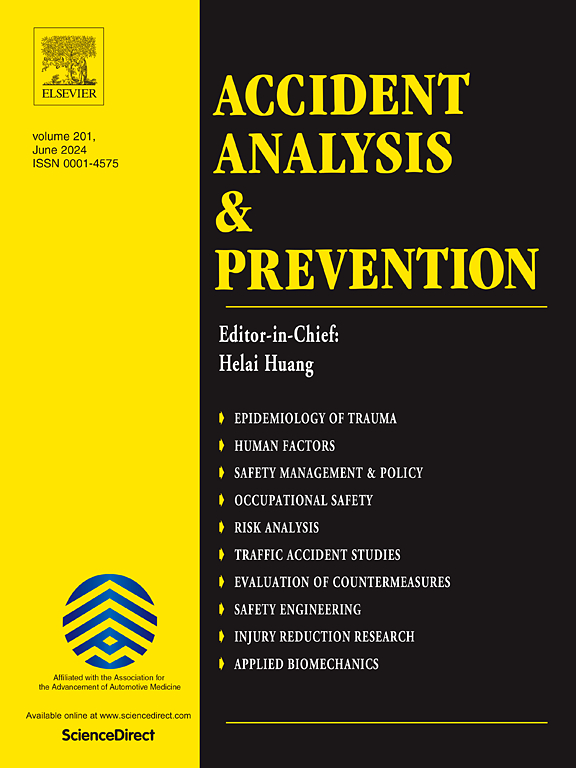高风险情景下驾驶员认知和决策行为的理解:漂移扩散视角
IF 6.2
1区 工程技术
Q1 ERGONOMICS
引用次数: 0
摘要
在混合交通系统中,确保自动驾驶汽车(AVs)与人类驾驶员之间的安全互动仍然是一项重大挑战,特别是在复杂、高风险的情况下。本文提出了一个将驾驶员行为的个体差异与共性相结合的认知-决策框架,以量化风险认知并建立动态决策模型。首先,建立了基于多元高斯分布的风险敏感性模型来表征个体风险认知差异。然后,引入基于漂移扩散模型(DDM)的认知决策模型,捕捉高风险环境中常见的决策机制。DDM通过整合初始偏差、漂移率和边界参数来动态调整决策阈值,以适应速度、相对距离和风险敏感性的变化,以反映不同的驾驶风格和风险偏好。通过在驾驶模拟器中模拟具有横向、纵向和多维风险源的高风险场景,该模型能够准确预测应急机动中的认知反应和决策行为。具体来说,通过结合驾驶员特定的风险敏感性,该模型可以动态调整关键DDM参数,从而允许在不同场景下进行个性化决策表示。与IDM、Gipps和MOBIL的比较分析表明,DDM更精确地捕捉了高风险情景下人类的认知过程和适应性决策。这些发现为模拟人类驾驶行为提供了理论基础,并为在现实交通环境中增强自动驾驶汽车与人的互动提供了重要见解。本文章由计算机程序翻译,如有差异,请以英文原文为准。
Understanding driver cognition and decision-making behaviors in high-risk scenarios: A drift diffusion perspective
Ensuring safe interactions between autonomous vehicles (AVs) and human drivers in mixed traffic systems remains a major challenge, particularly in complex, high-risk scenarios. This paper presents a cognition-decision framework that integrates individual variability and commonalities in driver behavior to quantify risk cognition and model dynamic decision-making. First, a risk sensitivity model based on a multivariate Gaussian distribution is developed to characterize individual differences in risk cognition. Then, a cognitive decision-making model based on the drift diffusion model (DDM) is introduced to capture common decision-making mechanisms in high-risk environments. The DDM dynamically adjusts decision thresholds by integrating initial bias, drift rate, and boundary parameters, adapting to variations in speed, relative distance, and risk sensitivity to reflect diverse driving styles and risk preferences. By simulating high-risk scenarios with lateral, longitudinal, and multidimensional risk sources in a driving simulator, the proposed model accurately predicts cognitive responses and decision behaviors during emergency maneuvers. Specifically, by incorporating driver-specific risk sensitivity, the model enables dynamic adjustments of key DDM parameters, allowing for personalized decision-making representations in diverse scenarios. Comparative analysis with IDM, Gipps, and MOBIL demonstrates that DDM more precisely captures human cognitive processes and adaptive decision-making in high-risk scenarios. These findings provide a theoretical basis for modeling human driving behavior and offer critical insights for enhancing AV-human interaction in real-world traffic environments.
求助全文
通过发布文献求助,成功后即可免费获取论文全文。
去求助
来源期刊

Accident; analysis and prevention
Multiple-
CiteScore
11.90
自引率
16.90%
发文量
264
审稿时长
48 days
期刊介绍:
Accident Analysis & Prevention provides wide coverage of the general areas relating to accidental injury and damage, including the pre-injury and immediate post-injury phases. Published papers deal with medical, legal, economic, educational, behavioral, theoretical or empirical aspects of transportation accidents, as well as with accidents at other sites. Selected topics within the scope of the Journal may include: studies of human, environmental and vehicular factors influencing the occurrence, type and severity of accidents and injury; the design, implementation and evaluation of countermeasures; biomechanics of impact and human tolerance limits to injury; modelling and statistical analysis of accident data; policy, planning and decision-making in safety.
 求助内容:
求助内容: 应助结果提醒方式:
应助结果提醒方式:


